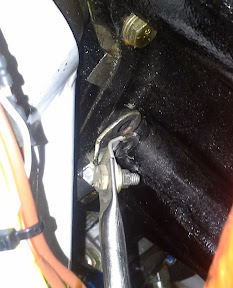JordanGrant
Well Known Member
FIXED! See post below for the final resolution.
----------------------------------------------------------------------
Airplane On Ground.
Currently stuck in Elko, NV with weather AND maintenance problems. I don't think even VAF can help me with the weather, but maybe you can give me some ideas on my maintenance problem. Here's the narrative:
-Flew from Boulder City, NV to Burley, ID on Friday. 3 hrs, No problems.
-Flew local sortie on Saturday, about 0.8 hrs, no problems.
-Flew from Burley, ID to Elko, NV today. 1.5 hrs, no problems.
-Attempted to fly from Elko to Las Vegas, but turned back due to weather. Total flight time 2.5 hrs on that leg.
-After landing back at Elko and trying to fire up - the battery is dead! Or at least, something is wrong and the battery can't spin the engine. The local FBO tried charging the battery for me for about 1.5 hrs at 2-3 Amps. Tried it again, same problem - won't spin the prop. Acts like it's a dead battery when trying to crank, but otherwise still reading 12+ volts.
-The battery is a PC680 that I bought new in March at the Madera Formation Clinic (thanks Slick), so it's barely been used.
-The electric system showed about 13.3V the whole flight (my system loses about a volt to the sensor, so that should have been a charging voltage of about 14.2 at the battery).
-My ammeter reads current on the main alternator output wire. It showed pretty normal output/demand during the flight (about 15 amps) except for one oddity. At one point I showed a spike to a very high amperage (in the 40s). I've had odd ammeter readings before (in the 100's! and dropping offline) and have chocked it up to something with my sensor. Regardless, I turned off my strobes and nav lights to start shedding load, and the reading went back down to normal, so I just left that off for the remainder of the flight - figuring I'd troubleshoot it later. All was back to normal at that point.
So, if you've read this far - thanks - here's my question:
Is there a failure mode of anything else in the starting system (i.e. Skytec starter, starter solenoid, etc) that would look like a low-powered battery? I'm going to try charging up the battery again tomorrow morning and hopefully I can get out of here, but I'm worried it might be something else and I might have to troubleshoot. I'm going to try and check the resistance from the battery through to the starter as well to see if I have any kind of problem there.
Any ideas you have are appreciated,
----------------------------------------------------------------------
Airplane On Ground.
Currently stuck in Elko, NV with weather AND maintenance problems. I don't think even VAF can help me with the weather, but maybe you can give me some ideas on my maintenance problem. Here's the narrative:
-Flew from Boulder City, NV to Burley, ID on Friday. 3 hrs, No problems.
-Flew local sortie on Saturday, about 0.8 hrs, no problems.
-Flew from Burley, ID to Elko, NV today. 1.5 hrs, no problems.
-Attempted to fly from Elko to Las Vegas, but turned back due to weather. Total flight time 2.5 hrs on that leg.
-After landing back at Elko and trying to fire up - the battery is dead! Or at least, something is wrong and the battery can't spin the engine. The local FBO tried charging the battery for me for about 1.5 hrs at 2-3 Amps. Tried it again, same problem - won't spin the prop. Acts like it's a dead battery when trying to crank, but otherwise still reading 12+ volts.
-The battery is a PC680 that I bought new in March at the Madera Formation Clinic (thanks Slick), so it's barely been used.
-The electric system showed about 13.3V the whole flight (my system loses about a volt to the sensor, so that should have been a charging voltage of about 14.2 at the battery).
-My ammeter reads current on the main alternator output wire. It showed pretty normal output/demand during the flight (about 15 amps) except for one oddity. At one point I showed a spike to a very high amperage (in the 40s). I've had odd ammeter readings before (in the 100's! and dropping offline) and have chocked it up to something with my sensor. Regardless, I turned off my strobes and nav lights to start shedding load, and the reading went back down to normal, so I just left that off for the remainder of the flight - figuring I'd troubleshoot it later. All was back to normal at that point.
So, if you've read this far - thanks - here's my question:
Is there a failure mode of anything else in the starting system (i.e. Skytec starter, starter solenoid, etc) that would look like a low-powered battery? I'm going to try charging up the battery again tomorrow morning and hopefully I can get out of here, but I'm worried it might be something else and I might have to troubleshoot. I'm going to try and check the resistance from the battery through to the starter as well to see if I have any kind of problem there.
Any ideas you have are appreciated,
Last edited:





